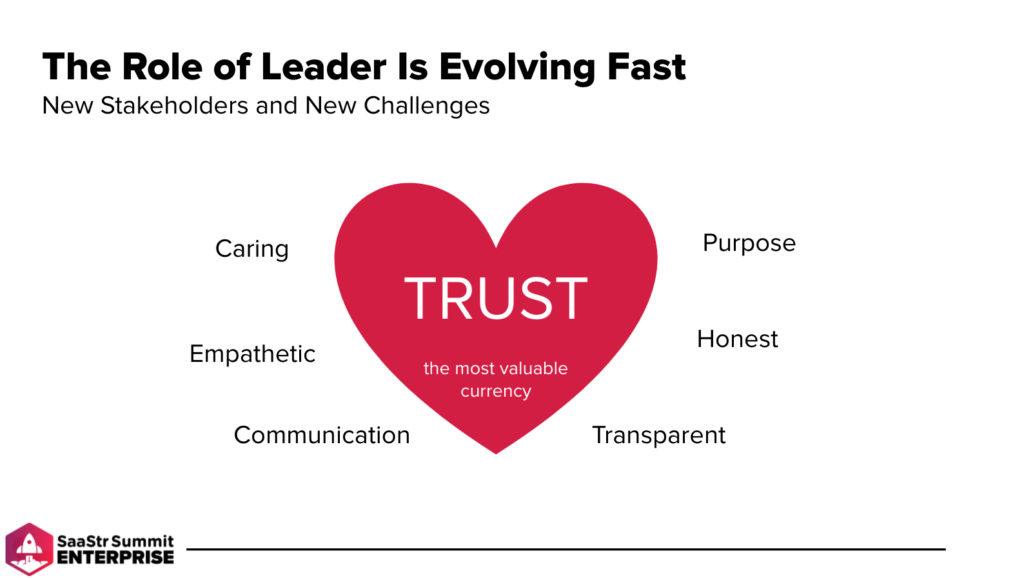- PagerDuty /
- Blog /
- Uncategorized /
- 3 Takeaways From SaaStr Summit: Transformation, Opportunity, and Social Responsibility
Blog
3 Takeaways From SaaStr Summit: Transformation, Opportunity, and Social Responsibility
At this year’s SaaStr Summit: Enterprise, our CEO Jennifer Tejada talked about why digital acceleration has been one of the positives to come out of the COVID-19 crisis, and why this time for change shouldn’t be wasted. Here are three key takeaways that she shared.
For CEOs, Transparency and Engagement Are Critical
The crisis, as Jenn explained, is accelerating permanent change in the role of the CEO. Leaders must place more emphasis on employee well-being, as well as transparency and continuous engagement to keep employees and customers informed in an era of misinformation. Values are critical, and CEOs need to show every decision made is values-led.
“Trust has become the most valuable currency,” she shared. “It takes years to build trust with customers and employees, and it can be destroyed in a heartbeat. That means that transparency, vulnerability, and continuous engagement with employees and customers are now mission-critical. As CEOs and leaders, we need to provide a compelling future—to keep people engaged in the mission so they continue to find fulfillment in their work.”

To do this, Jenn said, you must shift to a people-first mindset. Instead of checking in on how work is going, managers need to instead first ask how employees are doing emotionally and mentally. However, even the best management training and processes won’t prevent burnout. CEOs need to develop innovative policies around flexible working, childcare, and leave. PagerDuty has Dutonian days—spontaneous Fridays off so employees can step away from the screen and truly decompress. But, as Jenn explained, a one-size-fits-all approach isn’t the answer, and CEOs need to keep experimenting to create fulfillment for employees, while delivering on customer needs.
Automation Is the Key to Seizing Your Advantage
Jenn went on to talk about organizations needing to seize their advantage, and they can start by identifying and naming what those advantages are. They can ask, for instance, how their product is essential and whether it solves a current, urgent problem.

Next, organizations need to focus on turbo-powering their advantage, which is the hard part. Initiatives that may have been vital earlier in the year might not be so relevant now. These projects may need to be reprioritized or canceled.
“Ruthlessly prioritize your teams investments and activities, give them time to reshuffle and assess the progress, then repriortize again,” she shared. “This is a cycle that should take days and weeks, not months.
Jenn rounded off this point by reminding the audience that manual processes become a serious unmanageable burden that become expensive to solve—automation is key to seizing advantage.
“A leader’s job is to, as quickly as possible, shift resources to strengthen their advantage,” Jenn outlined. “But how do you free up your people to focus on being creative and innovative, to deepen your competitive moat, and to seize your advantage and take market share? You need to automate or eliminate anything that creates capacity for the stuff that matters.”
The Biggest Opportunity Is Social Impact
COVID-19 has accelerated the need for businesses to demonstrate purpose and corporate responsibility. Organizations need to go from “profit with a purpose” to helping solve the world’s biggest problems. Leaders may not have had exposure to these issues, but they are being amplified by COVID-19.
“COVID is taking a disproportionate toll on under-represented people,” Jenn said. “One vector is unemployment. How can we create employment opportunities for black and brown people, or offer skill-building to position them for knowledge-worker opportunities?”
She explained that it isn’t necessary for your product to directly solve any of these problems; rather, tech companies can be part of the solution. For example, organizations can redesign hiring and training practices, and partner with diverse organizations to create access and opportunity for people of color. They can also go beyond automating their supply chain or procurement processes by designing them to eliminate corruption, like child labor and racism, to make sure they leverage diverse vendors.
If you’d like to learn more from Jenn about the evolution of leaders, automating to accelerate your business, or how to take the lead in social responsibility, check out her full session here. Also make sure you register for PagerDuty Summit, happening virtually on September 21 – 24, to catch Jenn’s keynote!


